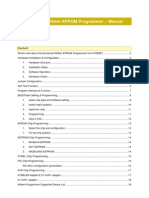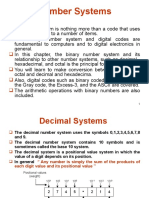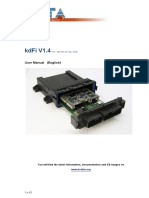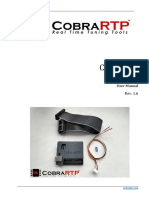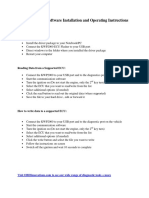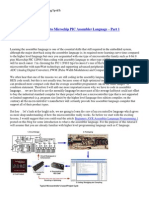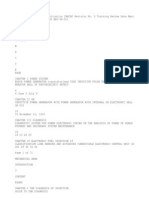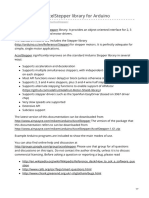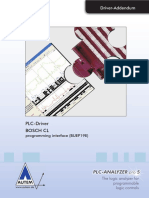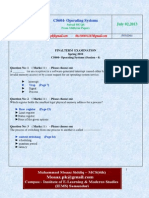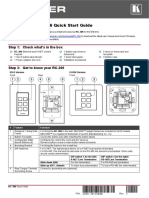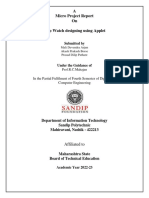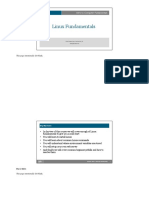Using PWM With Code Warrior
Using PWM With Code Warrior
Uploaded by
Gowrishankar GuptaCopyright:
Available Formats
Using PWM With Code Warrior
Using PWM With Code Warrior
Uploaded by
Gowrishankar GuptaCopyright
Available Formats
Share this document
Did you find this document useful?
Is this content inappropriate?
Copyright:
Available Formats
Using PWM With Code Warrior
Using PWM With Code Warrior
Uploaded by
Gowrishankar GuptaCopyright:
Available Formats
PWM 1
HCS12 FAMILY
EMBEDDED C USING CODEWARRIOR
PROGRAMMING THE PULSE WIDTH MODULATOR
Version 1.0
TECHNOLOGICAL ARTS #301-533 College St., Toronto, Ontario, Canada M6G 1A8 Toll-free: 1-877-963-8996 (USA and Canada) Phone: (416) 963-8996 Fax: (416) 963-9179
www.technologicalarts.com
PWM 2
BEFORE READING THIS GUIDE . . .
The source code herein is written in Embedded C using the Metrowerks CodeWarrior 3.1 IDE. If you are new to CodeWarrior 3.1 or embedded C, you can get a free copy of Technological Arts Embedded C Using CodeWarrior - Getting Started Manual from our website. This manual will show you how to start a project, where to write your source code, compile the code, and finally how to download it to your HCS12 board!
The Embedded C code written herein applies to the 9S12C derivatives of the HCS12 family, however . . . The PWM concepts are the same for all HCS12 derivatives. The embedded C coding structure for the PWM is similar for all HCS12s plus/minus a few registers. Where necessary, this document will suggest where you should be concerned about your HCS12 derivative.
www.technologicalarts.com
PWM 3
PULSE WIDTH WHAT? WHY DO I NEED TO LEARN THIS?
So you want to use your HCS12 module, from Technological Arts, to control the speed of a motor, or make a light flash? Well your eyes are on the right pages! The Pulse Width Modulator (PWM), built into most HCS12s, is the device that allows you to control the speed of a motor, cause an LED to flash, and vary the voltage/current applied to a load. The purpose of this guide is to: Introduce the concept of pulse width modulation Define the use and application for a pulse width modulator Identify the pulse width modulators (channels) in the HCS12 Show how an HCS12 PWM channel uses its registers to derives a pulse width modulated signal Demonstrate how to obtain the values for these PWM Registers Provide a sample source code used to program the PWM Analyze the source code
WHAT IS PULSE WIDTH MODULATION?
Pulse Width Modulation is the process of altering (modulating) the pulse width (duty cycle) of a TTL signal. Duty cycle is the duration of a TTL signals period that the signal is high. This value is given as a percentage. Figure 1 shows a TTL waveform with period T. During the period, the signal is low for 50% of the period and high for the remaining 50% of the period. We say that the signal has a duty cycle of 50%.
FIGURE 1
www.technologicalarts.com
PWM 4 Figure 2 shows three independent TTL waveforms with duty cycles of 70%, 80%, and 100% respectively. In this case the duty cycle of the TTL signal is increasing.
FIGURE 2
WHAT IS A PULSE WIDTH MODULATOR USED FOR?
A pulse width modulator is a device that is programmed to vary a TTL signals duty cycle. The duty cycle produced can be used to control the amount of voltage/current applied to a load. Consider figure 3. The pulse width modulator generates a signal whose duty cycle controls the power delivered to a motor.
FIGURE 3 If the duty cycle produced by the PWM is 0%, then transistor Q1 is turned off. Therefore, no power is delivered to the motor M.
www.technologicalarts.com
PWM 5 Table 1 shows what happens to the power delivered to the motor as the duty cycle increases. Duty Cycle 0% 20% 50% 80% 100% Transistor Conducts at: 0% 20% 50% 80% 100% TABLE 1 In general, the power delivered to a load is proportional the to the duty cycle applied to the circuit. As a result, the PWM can be used for varying light intensity, motor speed and pulsation of light. Average Power Delivered To Motor 0% 20% 50% 80% FULL POWER
THE PWM CHANNELS IN THE HCS12
In the HCS12, a PWM is referred to as a channel. For example, an HCS12 that has four PWM channels means that the HCS12 has four PWMs. Most HCS12 derivatives come with one or more PWM channel(s). The 9S12C32, Figure 4, has five PWM channels.
FIGURE 4 Each channel can be individually programmed to produce a signal with its own period and duty cycle without effecting the operations of neighbouring PWM channels. A channel must be enabled by the programmer in order to generate a modulated signal.
www.technologicalarts.com
PWM 6
DERIVING THE PULSE WIDTH MODULATED SIGNAL
The pulse width modulated signal, produced by a PWM channel, is derived from the HCS12s bus clock. This is accomplished by programming a series of PWM registers with values that scale the bus clock down to the desired pulse width modulated frequency. WARNING: Altering between run and boot mode will alter the output frequency of your PWM. The HCS12, due to PLL and HCS12s that support the serial monitor, operates under one of two bus clock speeds determined by the HCS12s operating mode (run mode or load* mode). Since the PWM frequency is derived from the bus clock you must consider the mode you are operating in. For example, the 9S12C32 has a run mode bus clock of 4MHz and a boot mode bus clock of 24 MHz.
* On the Technological Arts 32 pin dip module, load mode is also known as boot mode. The term load mode is used for all other HCS12s supporting the serial monitor.
www.technologicalarts.com
PWM 7
STEPS FOR PROGRAMMING THE PWM REGISTERS (8bit)
Each PWM channel has four programmable PWM registers used to reduce the bus clock to the desired pulse width modulated frequency. These registers are: PeriodValue DutyCycleValue PrescaleA ScaleA
The programmer selects the values for these registers. There is no set formula for determining these values. In the four step algorithm below, each formula (except for the duty cycle) is to help you keep track of how close you have reduced the bus clock frequency to your desired pulse width modulated frequency. STEP 1 SET THE PeriodValue REGISTER PeriodValue: scales the bus clock to a smaller size. PeriodValue: must be <= 256 FORMULA : Bus clock / (2* PeriodValue) STEP 2 SET THE DutyCycleValue REGISTER DutyCycleValue sets the duty cycle of the TTL signal DutyCycleValue must be <=256 Formula: Duty Cycle = (DutyCycleValue/ PeriodValue) x100% NOTE: Selecting Period and Duty Cycle Values Since: Duty cycle = (DutyCycleValue / Period Value ) x 100% the larger the value of PeriodValue selected the larger and more precise the range of duty cycle values we can represent. For example, assume we have Period Value =100. DutyCycle Values of 1, 2 . .100 correspond to the Duty Cycles of 1%, 2%. . . 100%. Conversely, assume we have Period Value = 25. A 50% duty cycle, for example, cannot be precisely obtained as Duty Cycle value =12.5. Decimal values can not be sent the to the PWMs registers. The closest value we can use is either 12 or 13 which does not yield a 50% duty cycle.
www.technologicalarts.com
PWM 8 STEP 3 - SET the PreScaleA REGISTER PreScaleA: further scales the value of bus clock after being reduced by the PeriodValue PreScaleA: The 3 bit combinations in table 2 show the value the Bus clock (referred to as Clock A) is scaled by Formula: (Scaled Bus Clock)/ (2^n) where n<=8 and Scaled Bus Clock = Bus clock / PeriodValue
TABLE 2 STEP 4- SET THE ScaleA REGISTER ScaleA: Further scales the clock after scaled by PeriodValue and PreScaleA ScaleA: must be <=256 Forumla: (Further Scaled Bus Clock) /ScaleA where Further Scaled Bus Clock = Bus Clock / PeriodValue / PrescaleA
IN SUMMERIZING THE REGISTER VALUES:
Desired PWM Frequency = Bus Clock / PeriodValue / PrescaleA / ScaleA
The example problem on the next page will help solidify your understanding of determining the register values.
www.technologicalarts.com
PWM 9
EXAMPLE
PROBLEM: Determine the PWM register values: PeriodValue (used the reduce the clock bus) DutyCycleValue PrescaleA ScaleA
required to generate pulse width modulated signal with 10Hz and a duty cycle of 50%. The 9S12C32 is used and will operate in run mode. SOLUTION: Since we are using the 9S12C32 in run mode, the bus clock = 4MHz. We have to reduce 4MHz to 10Hz by programming the PWM registers with the appropriate values. STEP 1: REGISTER PERIODVALUE
Let PeriodValue=250 Bus clock / (2 x Period Value) = 4MHz/(2x 250) = 16kHZ 250 was selected to give us a nice round figure which can be further reduced by the Scale A Value and the PrescaleA STEP 2: REGISTER DUTYCYCLEVALUE
Let DutyCycleValue=125 Duty Cycle = (DutyCycleValue/ PeriodValue) x100% Duty Cycle=(125/250) *100% = 50%
www.technologicalarts.com
PWM 10 STEP 3: REGISTER PRESCALE A
Let PrescaleA = 4 NOTE: 4 is the value submitted to the register. 2^4=16 is the factor that the bus clock is reduced by (Bus clock / PeriodValue ) / (2^n) (16kHz)/ (16) = 1kHz 1Khz can be easily reduced to 10 Hz by dividing by 100. STEP 4: REGISTER SCALED A
Scaled A Value = 100 1kHz / Scale A Value =10 Hz
ONE NOTE BEFORE SHOWING YOU THE CODE . . .
For simplicity we determined the register values in the order of PeriodValue (used the reduce the clock bus) DutyCycleValue PrescaleA ScaleA
However, when we program the HCS12 we reverse the order. Dont worry the values for each register do not change, only the order they are programmed, in essence: ScaleA PrescaleA PeriodValue (used the reduce the clock bus) DutyCycleValue
Changing PWM signal at runtime You can change the values of the DutyCycleValue Register and the PeriodValue Register during runtime. Each PWM channel has its own counter. Changes to the period and duty cycle do not take effect until the counter resets back to 0. Thus there is no signal overlap when the signal transitions from one frequency to another. And with out further a due here is the embedded C code for our 10Hz 50% duty cycle PWM signal!
www.technologicalarts.com
PWM 11
PROGRAMMING THE MICROCONTROLLER
The Embedded C code that programs the HCS12 PWM to generate the 10Hz 50% signal derived on the previous page is listed below. In CodeWarrior, create a new project called PWM. Open the main.c from the source window. Delete the code that is in there. Copy and paste the following code: //------------------------------------- START OF CODE --------------------------------#include <hidef.h> /* common defines and macros */ #include <mc9s12c32.h> /* derivative information */ #pragma LINK_INFO DERIVATIVE "mc9s12c32" #pragma CODE_SEG DEFAULT void main(void) { //Enabling portT for PWM0 MODRR =0x01; /* The line MODRR=0x01 may not be necessary if your PWM in not multiplexed with the Timer module. Check the block diagram of your circuit. */ PWMCLK=0x01; PWMSCLA=0x32; PWMPRCLK=0x04; PWMPER0=0xF9; PWMDTY0=0x7B; PWME=0x01; while(1){ } } //------------------------------------ END OF CODE ---------------------------------------
www.technologicalarts.com
PWM 12 MAKE THE SOURCE CODE PWM DOWNLOAD THE CODE TEST
Click MAKE on CodeWarrior, set your HCS12 module into boot mode, hit reset and then download your program to the HCS12. Once the program has downloaded, switch the module into run mode and then select reset again. If you have done everything correctly the user LED should be flashing! NOTE: If you do not have a user LED connected to PWM0 (PT0) you can use the circuit in figure 5 and connect it to PT0 using a jumper wire. Use the datasheet for your HCS12 board to identify the pin number corresponding to PT0.
FIGURE 4 Dont worry if you dont understand the source code on the previous page. On the next page we will analyze it.
www.technologicalarts.com
PWM 13 ANALYZING THE SOURCE CODE In essence, the purpose of the code is to initialize each of the appropriate PWM registers to produce the 10Hz 50% duty cycle. This section briefly describes each register accessed in the source code. NOTE: each bit in the MODRR, PWMCLK and PWME register corresponds to the PWM channel. For example: PWME=0x01 Enables PWM0 (PWM channel 0), by setting bit 0 , and PWMCLK=0x01 sets PWM0 to use the ScaleA clock NOTE: this section refers to the registers on the 9S12C32 derivative. Consult Motorolas documentation - S12PWMxxx.pdf REGISTER DESCRIPTIONS MODRR =0x01; This line may not be necessary if your PWM is not multiplexed with the Timer module. Check the block diagram of your HCS12. A set bit means that the corresponding PWM channel will be multiplexed to corresponding bit onPort T. A cleared bit means the corresponding timer channel will be multiplexed to the corresponding bit on Port T In this line PWM0 is multiplex to Port T (PT0) PWMCLK=0x01; BIT 0 ie- PWM0 is set meaning that the Scaled A clock will be use If BIT 0 were cleared, Clock A would be modulated. PWMSCLA=0x32; Sets the Scale A the Hex equivalent of 100 PWMPRCLK=0x04; Sets the Prescale A to the Hex equivalent of 4. PWMPER0=0xF9; Sets the PeriodValue to the Hex equivalent of 250. PWMDTY0=0x7B; Sets the DutyCycleValue to the Hex equivalent of 125 PWME=0x01; Enables PWM0. We enable the PWM channels last. The moment you enable a PWM channel, it starts outputting a signal with the values contained in the registers. We want to make sure that our correct register values are loaded before the PWM is enabled.
www.technologicalarts.com
PWM 14
16 BIT PERIODVALUE AND DUTYCYCLEVALUE REGISTERS
The PeriodValue and the DutyCycleValue registers can each extend their value range up to 65536 to allow more precise values for duty cycle. This is done by concatenating two PWM channels, forming a 16bit PeriodValue Register and a 16bit DutyCycleValue. When concatenating two PWM channels, either PWM0 and PWM1 or PWM2 and PWM3 the higher PWM channel will produce the output signal. Refer to the Motorola documentation - S12PWMxxx.pdf for more information on concatenating under the register description chapter.
SUMMARY
The pulse width modulator is an HCS12 device which can produce a TTL signal whos frequency and duty cycle can be programmed PWMs can be found in most HCS12s. Depending on the derivative, Most HCS12s have 1 or more PWMs known has PWM channels. Each PWM channel has four programmable registers programmed to derive a desired frequency and duty cycle from the bus clock The method for determining the values of these registers are describe in this guide IN SUMMERIZING THE REGISTER VALUES: Desired PWM Frequency = Bus Clock / PeriodValue / PrescaleA / ScaleA The duty cycle and frequency can be programmed to changed during runtime Programming the PWM in embedded C, and a description of the registers programmed, are described in this guide
HCS12 RESOURCES
Motorola Documentation Motorola documentation for your HCS12 derivative can be found on the Technological Arts resource CD or on the web at www.technologicalarts.com PWM Register Names, and PWM block diagrams can be found in Motorola documentation - S12PWMxxx.pdf
www.technologicalarts.com
You might also like
- Professional Developer: Core Competencies: OverviewDocument6 pagesProfessional Developer: Core Competencies: Overviewziaul khan0% (2)
- Son Nguyen's Blog - How To Install HASP MultiKey USB Dongle Emulator On Windows 7 64 BitDocument27 pagesSon Nguyen's Blog - How To Install HASP MultiKey USB Dongle Emulator On Windows 7 64 Bitmoolmanspitcontrol0% (1)
- Audi A6 DataDocument5 pagesAudi A6 DataManikanta JNo ratings yet
- Understanding ECU Remapping Audi TT 1 8t TutorialDocument62 pagesUnderstanding ECU Remapping Audi TT 1 8t TutorialAndrEi Andrey100% (1)
- Lab-Project 5: Viewing Segments and Clusters With A Hex EditorDocument13 pagesLab-Project 5: Viewing Segments and Clusters With A Hex EditorNguyễn Ngọc Bảo LongNo ratings yet
- Enhanced Willem Programmer ManualDocument20 pagesEnhanced Willem Programmer Manualtoner5No ratings yet
- 2-1 Digital Numbering and CodingDocument62 pages2-1 Digital Numbering and Codingseyoum shimelsNo ratings yet
- KD Fi V14 Cinch R10 EN20130624Document12 pagesKD Fi V14 Cinch R10 EN20130624openjavier5208No ratings yet
- Manual MotronicRT (EN)Document25 pagesManual MotronicRT (EN)apek1No ratings yet
- Racing Spark Plugs Performance ApplicationsDocument7 pagesRacing Spark Plugs Performance ApplicationsAbdul WasayNo ratings yet
- Et STM32F103Document25 pagesEt STM32F103priyosantosaNo ratings yet
- Mo TronicDocument2 pagesMo TronicdromakiNo ratings yet
- BDF - AUT - 16 - 001 - Eng - TP 6 Poles To 8 Poles Motors - OPD and DSC - Rev1-1 PDFDocument10 pagesBDF - AUT - 16 - 001 - Eng - TP 6 Poles To 8 Poles Motors - OPD and DSC - Rev1-1 PDFDilanka RajithamalNo ratings yet
- PIC Notes Embedded SystemsDocument5 pagesPIC Notes Embedded SystemsVonn Salty100% (3)
- KWP2000 InstallationDocument6 pagesKWP2000 InstallationKeduar NosferatusNo ratings yet
- Ostrich 1 Operation Moates SupportDocument5 pagesOstrich 1 Operation Moates Supportheime jonkersNo ratings yet
- Grizzles: The $20 Ebay Vag-Com Cable Walkthrough RevisitedDocument8 pagesGrizzles: The $20 Ebay Vag-Com Cable Walkthrough Revisitedbcr888No ratings yet
- Introduction To MicrocontrollerDocument27 pagesIntroduction To Microcontrollerpcalver2000100% (2)
- The Overall Motronic SystemDocument12 pagesThe Overall Motronic SystemKanagasundram JathursajanNo ratings yet
- VW/Audi 1.8T Transverse (FWD) Ignition Wiring Replacement Kit Installation Guide Skill Level 2 - ModerateDocument21 pagesVW/Audi 1.8T Transverse (FWD) Ignition Wiring Replacement Kit Installation Guide Skill Level 2 - ModerateKushal ExpertNo ratings yet
- Building My 4G LTE Mimo Antenna Prototype - About Technologies For Your Digital HomeDocument1 pageBuilding My 4G LTE Mimo Antenna Prototype - About Technologies For Your Digital HomemoannaNo ratings yet
- Bosch ME 7 PDFDocument3 pagesBosch ME 7 PDFBagrinNo ratings yet
- PIC ControllerDocument74 pagesPIC ControllerVikas Jaiswal100% (2)
- MED Motronic Case StudyDocument13 pagesMED Motronic Case StudyÃmit Řajgadkar100% (1)
- Service Training: Vorsprung Durch Technik WWW - Audi.co - UkDocument56 pagesService Training: Vorsprung Durch Technik WWW - Audi.co - UkAntónio FernandesNo ratings yet
- MPPS V13CarListDocument22 pagesMPPS V13CarListLittleJoe VipNo ratings yet
- Injection and Ignition SystemsDocument18 pagesInjection and Ignition Systems4gen_7No ratings yet
- KessDocument1 pageKessDarjanNo ratings yet
- Motronic Checksum Correction PDFDocument4 pagesMotronic Checksum Correction PDFasser_salehNo ratings yet
- Vems v3 DocumentationDocument18 pagesVems v3 DocumentationRuben AparicioNo ratings yet
- AccelStepper Library For Arduino3Document7 pagesAccelStepper Library For Arduino3vr_xlentNo ratings yet
- Theory: CAN-Bus: 1 General InformationDocument7 pagesTheory: CAN-Bus: 1 General InformationDileep Kumar100% (1)
- Bosch Motorsport Catalog07Document184 pagesBosch Motorsport Catalog07blancohccNo ratings yet
- "LCD Device Driver" For Reconfigurable Instrument ClusterDocument6 pages"LCD Device Driver" For Reconfigurable Instrument ClustersrikanthshenoyNo ratings yet
- Fitting Instructions Radio Communication SystemsDocument40 pagesFitting Instructions Radio Communication Systemsemiliano_387665009No ratings yet
- rns-315 (Eng)Document2 pagesrns-315 (Eng)danutprintisorulNo ratings yet
- Ross-Tech VAG-COM USB Cable Instructions (For Audi Auto Computers)Document3 pagesRoss-Tech VAG-COM USB Cable Instructions (For Audi Auto Computers)urcanfleurNo ratings yet
- Injection Completo 960 V22 Ingles PDFDocument29 pagesInjection Completo 960 V22 Ingles PDFbogdanNo ratings yet
- Bosch Alfa ApplicationsDocument4 pagesBosch Alfa ApplicationsJavier0043No ratings yet
- Robert Bosch ExpDocument1 pageRobert Bosch ExpvikramsimhareddyNo ratings yet
- ChangelogDocument56 pagesChangelogTancu SebastianNo ratings yet
- Codificare VWDocument2 pagesCodificare VWnicolicescu_claudiu5152No ratings yet
- Iud3 2Document17 pagesIud3 2Andrés ImpaNo ratings yet
- Instrument Cluster Description and Operation PDFDocument2 pagesInstrument Cluster Description and Operation PDFAlonso BarrónNo ratings yet
- Otocheck2 MODE D EMPLOI PDFDocument27 pagesOtocheck2 MODE D EMPLOI PDFBolinha's Wash ClubNo ratings yet
- Bosch Me7.6.1 1033Document2 pagesBosch Me7.6.1 1033Rafael FávaroNo ratings yet
- SDA555 XFLDocument12 pagesSDA555 XFLgigel1980No ratings yet
- Optimal Valve TimingDocument19 pagesOptimal Valve TimingjehadyamNo ratings yet
- Audi Rescue Data Sheets (E-Tron GT - Sportback - 2020 - 5d - Electric - EN)Document4 pagesAudi Rescue Data Sheets (E-Tron GT - Sportback - 2020 - 5d - Electric - EN)caragan1970No ratings yet
- PLC-Driver (V5) Bosch CL - Programming Interface (BUEP19E)Document8 pagesPLC-Driver (V5) Bosch CL - Programming Interface (BUEP19E)AdelmoKarig100% (2)
- Tunerpro and Burn A ChipDocument2 pagesTunerpro and Burn A ChipSutiknoNo ratings yet
- Dme 1.1 1.3Document7 pagesDme 1.1 1.3Minas HarutyunyanNo ratings yet
- Cobb Tuning: Accessport Calibrations Mazdaspeed3Document7 pagesCobb Tuning: Accessport Calibrations Mazdaspeed3zanzer1No ratings yet
- Coding Systems - ASCII and UnicodeDocument23 pagesCoding Systems - ASCII and UnicodeIbrahim AbdulaliNo ratings yet
- SSP 23 18 L 110kw Turbo Petrol Engine 18 L 92kw Petrol EngineDocument34 pagesSSP 23 18 L 110kw Turbo Petrol Engine 18 L 92kw Petrol Enginehalil ibrahim soysal100% (1)
- Memorias Ecus Con Checksumpdf PDFDocument276 pagesMemorias Ecus Con Checksumpdf PDFMichael Sezenias0% (1)
- 16-B PWM U O - C T Relevant Devices: IT Sing AN N HIP ImerDocument12 pages16-B PWM U O - C T Relevant Devices: IT Sing AN N HIP ImerLauderi MartinsNo ratings yet
- Slaa 116Document21 pagesSlaa 116misaelrodrigoNo ratings yet
- Digital Signal Processing Project Report: Ihtisham Ul HaqDocument9 pagesDigital Signal Processing Project Report: Ihtisham Ul Haqihtishamul HaqNo ratings yet
- M4 Micro OneNoteDocument6 pagesM4 Micro OneNoteAryan RaiNo ratings yet
- PWM, A Software Solution For The PIC16CXXX: MethodsDocument14 pagesPWM, A Software Solution For The PIC16CXXX: Methodsjavixl1No ratings yet
- Ece3044 Wearable-technology-And-iot Eth 1.0 49 Ece3044Document2 pagesEce3044 Wearable-technology-And-iot Eth 1.0 49 Ece3044Atishay TiwariNo ratings yet
- Boot - What Is The Booting Process For ARM - Stack OverflowDocument3 pagesBoot - What Is The Booting Process For ARM - Stack OverflowshivamSRINo ratings yet
- Web API Best PracticesDocument63 pagesWeb API Best PracticesHernan JassoNo ratings yet
- CH 1Document23 pagesCH 1Vivek BhogaytaNo ratings yet
- Oracle Grid Infrastructure 11g Administer ASM - D74608GC10 - 1080544 - USDocument3 pagesOracle Grid Infrastructure 11g Administer ASM - D74608GC10 - 1080544 - USJinendraabhiNo ratings yet
- EziWeigh6 User Manual (En) - 0Document16 pagesEziWeigh6 User Manual (En) - 0Taller ElectrónicoNo ratings yet
- 00 AutoLISP - AfraLISPDocument6 pages00 AutoLISP - AfraLISPkomailNo ratings yet
- CS604 - Finalterm Solved Mcqs Solved With ReferencesDocument49 pagesCS604 - Finalterm Solved Mcqs Solved With ReferencesPrincessRabiNo ratings yet
- 20DMXs FWupdate enDocument1 page20DMXs FWupdate enAbhishek SinghNo ratings yet
- Data Structures Module 3 QB Complete SolutionsDocument73 pagesData Structures Module 3 QB Complete SolutionsRamu SitaNo ratings yet
- Operating System User InterfaceDocument38 pagesOperating System User InterfaceKissanna SinclairNo ratings yet
- CPL Lab Manual 2017-18 SchemeDocument18 pagesCPL Lab Manual 2017-18 Schemeanand_gudnavarNo ratings yet
- COMMSCOPE - Antenna Sharing Configuration Builder ToolDocument6 pagesCOMMSCOPE - Antenna Sharing Configuration Builder Toolyou are awesomeNo ratings yet
- Directives DDDocument19 pagesDirectives DDtariku fkaduNo ratings yet
- RC-306 Quick Start Guide: Step 1: Check What's in The BoxDocument4 pagesRC-306 Quick Start Guide: Step 1: Check What's in The BoxRamon VerdeguerNo ratings yet
- 1st Y 2nd Year Pairing Scheme 2019Document11 pages1st Y 2nd Year Pairing Scheme 2019NAWAB SAHABNo ratings yet
- Install PHP in IIS 7 As FastCgi ModuleDocument7 pagesInstall PHP in IIS 7 As FastCgi ModuleCarlos Eduardo Muñoz CruzNo ratings yet
- A Micro Project Report On Stop Watch Designing Using Applet: Submitted byDocument22 pagesA Micro Project Report On Stop Watch Designing Using Applet: Submitted byDevendra Mali100% (1)
- Object-Oriented Programming: Philippine Science High SchoolDocument2 pagesObject-Oriented Programming: Philippine Science High SchoolEarn8348No ratings yet
- (Check Point France) CheckMates - Expert Talk - Troubleshooting Firewall, Cluster, VPNDocument77 pages(Check Point France) CheckMates - Expert Talk - Troubleshooting Firewall, Cluster, VPNAmine MHNo ratings yet
- SEC201.2 Linux FundamentalsDocument213 pagesSEC201.2 Linux FundamentalsnanoanxoNo ratings yet
- Mobile ApplicationsDocument30 pagesMobile ApplicationstsurendarNo ratings yet
- Chapter 2 - Optimizing The Performance of QueriesDocument67 pagesChapter 2 - Optimizing The Performance of QueriesKilian GuerraNo ratings yet
- AssemblyResolve V1 0 ENDocument14 pagesAssemblyResolve V1 0 ENAditiya MistryNo ratings yet
- Connections: Quick Start GuideDocument2 pagesConnections: Quick Start GuideLeo NidasNo ratings yet
- Chapter 2 Network Technology NotesDocument12 pagesChapter 2 Network Technology NotesTrynaBeGreatNo ratings yet
- TesteDocument2 pagesTestePedro Ivo Alves FonsecaNo ratings yet
- SiebelSysDiag PDFDocument184 pagesSiebelSysDiag PDFBhaskar KumarNo ratings yet





